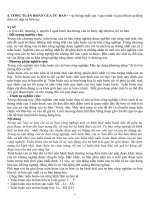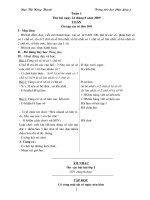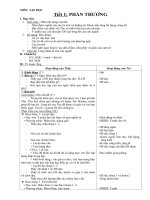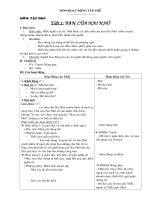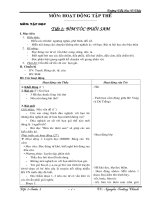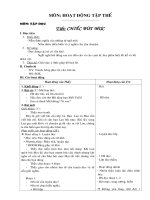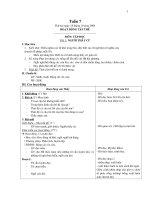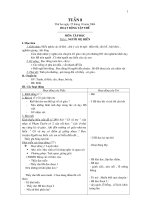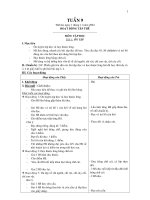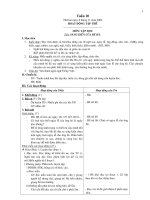Tuan 14,15.
Bạn đang xem bản rút gọn của tài liệu. Xem và tải ngay bản đầy đủ của tài liệu tại đây (211.77 KB, 27 trang )
Date.....17...month.....11.....year..2008
N
0
53
Unit 7: celebrations
Period 2: Reading.
I. Objective
II. Teaching aids Similar to N
0
52
III. Method
IV. Procedure.
T
Teacher ‘s activities Students’ activities
1. Checking – Up
Call on two Ss to write all the new
words
Write all the new words
2. New lesson
2.2. While you read
♦ Task a
- Asks them to read the task and
guess which statement is true and
which are false.
Walks round to offer help.
New Year’s Celebrations Around
the World:
Prepare hand outs then give them
hand out.
- Read the text individually in
silence.
- Ask for help if necessary.
- Stand up and read aloud.
- Read the text and complete the
handouts.
1. January 1
st
2. Making New Year’s resolutions.
3. Shiite
4. Processions gathering
5. Rosh Hashsnah
6. September or October
7. Vietnamese
8. first three days of first lunar
month.
9. engaging in games and
entertaining activities
♦ Task b
- Ask them to work in pairs.
1. How long has January 1
st
been
New Year’s Day?
2. What is the origin of January?
Work in pairs.
1. Since 1582.
2. Its original meaning was James –
the Roman god of doors and of
beginnings.
3. Do Shiite people celebrate their
New Year in January?
4. What month on the Gregorian
calendar does Tishri normally
fall on?
5. Who may get LI XI or TIEN
MUNG TUOI? What is it?
6. It can be interfered from the text
that the following may be
among the foods and drinks
typically served during Tet.
7.
8.
9.
3. No, they don’t. They observe
their New Year in the 1
st
Month
of the Islamic calendar.
4. September or October.
5. Children often receive LIXI or
Lucky money put inside red
envelopes.
6.
Glutinous ricecakes beer
wine coke
candled ginger fruits
sausages tea
7. Some Tet Nguyen Dan’s…..
Dragon / unicorn / dancing .
Wrestling
Buffalo fighting
8. During Shiit and Jewish New
Year’s Day, people mourn by
beating their chests or by fasting
to show repentance. New Year’s
Days in Europe, the United
States, and Viet Nam are joyuos
and festive.
9. (Students’ answers may vary.)
2.3 Post – reading
- Ask Ss to work in groups : Give a
list of your favorite songs you
would select for whole family to
listen to during the new year days
- Work in groups
3. Homework.
- Learn all the vocabularies by
heart.
-Prepare for the next lesson.
Write the homework
N
0
54
Date....18......month....11.....year...2008
Unit 7: celebrations
Lesson three: Listening.
I. Objective .
- Help Ss listen to songs then numbering and gap filling.
II. Teaching aids: cassette and record.
III. Method: Integrated, mainly communicative.
IV. Procedure
T Teacher ‘s activities Students’ activities
5’
1. Warm-up
Ask them to sing an English song. Sing a English song
8’
2. New lesson
2.1 Before listening
♦ Task a
- Ask them to listen to the three songs
and check.
- Call on some Ss to give their answer
- Listen to the tape and give their
answers in front of the class:
• New Year: Happy New Year.
• Christmas: Jingle bell.
• Birthday: Happy birth day to you
2.2 While listening
♦ Task b
- Asks them to listen and complete the
songs
- Play the cassette the first time.
- Checks their answers.
- Plays the second time.
- Checks their answers.
- Plays the third time slowly, sentence
by sentence.
- Give correct answers.
- Ask them to compare with their
answers.
- Work in pairs.
- Listen and check.
- Stands up and reads
1. Fireworks 6. hopes
2. party 7. snow
3. time 8. laughing
4. may 9. bells
5. friend 10. ride
♦ Task c
- Asks them to listen again and answer
the questions.
- Play the cassette recorder once.
- Calls them to stand up and read out.
- Gives correct answers
- Listen again and answer the questions:
HAPPY NEW YEAR by ABBA.
JINGLE BELLS by PIERPONT
2.3. After listening.
- Asks them to sing the song again.
- Calls some Ss to stand up and read.
- Asks them to remarks.
Ask them to copy
- Sing the song again
3. Homework
- Learn by heart the song.
- Prepare for the next lesson - Do it at home.
.
Date....19......month....11.....year...2008
N
0
55
Unit 7: celebrations
Period 4: Speaking.
I. Objective .
- Help Ss talk about celebration.
II. Teaching aids:
Pictures, photos and real people.
III. Method:
Integrated, mainly communicative.
IV. Procedure
T Teacher ‘s activities Students’ activities
1. Warm-up:
Asks them to draw a graph of their study
result.
-Work in pairs.
Ask for help if necessary.
2. New lesson
2. 1 Before speaking.
♦ Task a
- Ask them to work in pairs to talk about
preparations for celebrations.
- Explain some new words.
- Calls them to stand up and say out.
Tam: Christmas is coming round the
corner. Any plan for the occasion?
Tam: Can you tell me more about the
preparations for the celebrations?
Tam: I see. And when the day is coming
near..?
Tam: There must be a lot of fun.
- Work in groups. Ask for help if
necessary.
- Work in pairs. Do in 4’
- Stand up and read aloud.
- Compared and correct.
Tom: sure. We’re flying home after this
camp. Most Americans always come home
for a Christmas family reunion.
Tom: Certainly. As soon as December
begins, we spend weeks decorating the
home, planning parties and shopping for
gifts, to avoid the Christmas rush, you
know. Also, it is interesting to stay up late
to write letters and cards.
Tom: Everybody will be busy choosing
Christmas trees, decorating Christmas
crèches, wrapping presents and of course
preparing foods.
2.2. While speaking
♦ Task b.
- Have them do task b in group of four.
- Let them do in 10’
- Call some of them to stand up and read.
- Give them useful expressions.
- Work in pairs
- Read the model carefully then make a
dialogue..
- Practice making a dialogue of
Before Tet:
People going home for family reunion.
Buying foods and drinks, preparing
traditional foods like banh chung, bang
tet, decorating the house.
New year’s Eve: making offering to
ancestors.
- going to church or pagoda or out on the
street.
- counting down to the New Year,
watching firework
During Tet: visiting parents.
Grandparents, relatives, teachers,
friends, colleagues..........
A. Tet is approaching. Any plan for the
occasion?
B. Certainly. We’re preparing for Tet
celebration.
A. Could you tell me about your
preparation for Tet?
B. Sure. One week before Tet, most people
go home for family reunion after enjoying
the end-year-party called Tat Nien. Then
they go shopping for foods and gifts.
A. Are they very busy with home
decorations and food preparations?
B. Of course. Everybody except very old
people and the very young children, is very
busy with decorating homes and preparing
foods.
A. Oh. I see. Thank you very much and
hope you’ll enjoy your Tet holidays.
2.3. After speaking.
♦ Task c.
- Getting ss to work in pairs to talk about
TET.
- Calls one or two ss to stand up and say
out
- Stand up and say out.
3. Homework.
- Practice speaking individually at home
- Prepare for the next lesson
- Do it at home
- Look up new words
Date....20......month....11.....year...2008
N
0
56
Unit 7: celebrations
Period 5:: Writing.
I. Objective .
- Help Ss write a proposal for a celebration activity.
II. Teaching aids:
Pictures, photos and real people.
III. Method:
Integrated, mainly communicative.
IV. Procedure
T Teacher ‘s activities Students’ activities
1. Warm-up:
Asks them to draw a graph
of their study result.
Work in pairs.
Ask for help if necessary
2. New lesson
2. 2. Before writing .
Task a.
- Asks them to work in pairs
to under line important
words.
- walk round to offer help.
-Call some of them to stand
up and read aloud.
- Correct mistakes.
- Check the answers
- Work in pairs to under line important words.
- Stand up and read aloud.
Event Dinner party to celebrate Teacher’s
Day
Objectives - Expressing students’ gratitude to
teachers
- Having a good time / fun.
Time and
Venue
- November 20 ( 5:30 p.m – 8:00p.m)
-Common Room B
Participants - All members of class 11A (40) and
teachers(10)
Preparations
and students
in charge
- Foods and drinks – (Xuan,Thu, Minh
and Hung)
- Flowers,cards, gifts (Lan, Hoa)
.
- Ornaments and room decorations
(Van, Vi, Quan)
Activities - Welcoming speech and thank you
speech ( Trang)
- Speech(es) from teacher(s).
- Dinner party (foods and drinks are
served (buffet))
- Music performances (Linh, Thao,
Son, Nga, Tu, Ha, Phuong)
Expenses - Foods and drinks
- 30. 000 dong / person x 50 = 1,500
000 dong
- Flowers, gifts, cards, ornaments =
300. 000 dong
- Contingency = 200. 000 dong
⇒ Estimated sum : 2, 000. 000 dong
⇒ Contribution : 50. 000 dong /
student
Prepared by - (Student’s name)
Approved
by
- teacher’s name (homeroom teacher)
2.2 While – writing
- Ask Ss to write a proposal
based on the task a
- Let Ss exchange their
writings with a friend and
check together
- Call on some Ss to write
their writings on the board
- Write a proposal
- Exchange their writings with a friend and
check together
- Write their writings on the board
2.3 Post – reading
- Correct necessary mistakes
- Collect all the mistakes and
write them on the board
- Listen to the teacher
- correct their own mistakes
3. Home work.
- Ask them to do it at home.
- Prepare for the next lesson
- Rewrite it at home.
- Look up the dictionary for new words
Date....26......month....11.....year...2008
N
0
57
Unit 7: celebrations
Period 6: : Language Focus
I. Objectives
- Help Ss understand about fractions, review relative clause
II. Teaching aids:
Pictures, photos and real people.
III. Method:
Integrated, mainly communicative.
IV. Procedure
T Teacher ‘s activities Students’ activities
1. Warm Up
- Asks them to write the following
number into words.
1/ 5
6/7
4/9
3.7
1,347605
- Write the following number into words.
0ne / a fifth
Six sevenths
Four ninths
Three point seven
One million, three hundred forty
seven thousand and six hundred and
five
2. New lesson
2.1 Word study: Genitive’s
- Explain the form & use of Genitive’s
Form:
SINGULAR noun +’s
PLURAL noun + ‘
IRREGULAR plural ‘s
TIME EXPRESSIONS +’s
ONE NOUN +’s
Use:
We normally genitive’s for people or
animals ; for things, we normally use
“of ”.
Eg: The roof of the house
♦ Task a
- Asks them to work in pairs.
- Ask them to listen and repeat.
- Asks them to practice reading.
- Calls some to stand up and read.
Write down and give some examples
My brother’s car
My parents’ home
A children’s pen
Next week ‘s meeting, yesterday’s
newspaper, three weeks’ holiday
Tom and Mary ‘s wedding and Mr.
and Mrs. Brown ‘s house
Note:
With the beginning / end / top / bottom /
front / back / middle / side..
Eg: The back of the car (not the car’s
back)
- Work in pairs
- Listen and repeat.
- Practice reading
1. Children’s books.
- Let Ss work in pairs to ask and answer
some questions, using genitive
construction.
S1: When do people celebrate the day
for teachers?
S3: What do you usually do on the day
for women?
S5: What do you usually do on the day
for Mothers?
2. Master’s degree
3. Mother’s day.
4. Fifteen minutes’ break.
5. Revolutionary Invalids & Martyrs’
Day
6. Mile’s distance.
7. Heaven’s sake.
8. Men’s department store.
- Ask and answer some questions, using
genitive construction
S2: They celebrate Teachers’ Day on
November 20.
S4: I usually buy flowers for my mother
on Women’s Day.
S6: I usually give my mother some
flowers and help her do housework on
Mother’s Day.
3. Homework
- Ask Ss do the following exercises at
home .
1. These shoes belong to my friend.
2. What are your teachers called?
3. These are clothes for children.
4. The meeting tomorrow has been
canceled.
5. Exports from Britain to the United
States have fallen recently.
6. This is a magazine for women.
7. It is a school for girls.
→ These…………………….shoes
→ What ……………………..names?
→ These …………………… clothes.
→ Tomorrow………………….canceled.
→ Britain ……………the United States
have fallen recently
→ This ………………….magazine.
→ It is ……………………… school.
Date....27......month....11.....year...2008
N
0
58
Unit 7: celebrations
Period 7 : Language Focus
I. Objectives
- Help Ss understand about fractions, review relative clause
II. Teaching aids:
Pictures, photos and real people.
III. Method:
Integrated, mainly communicative.
IV. Procedure
T Teacher ‘s activities Students’ activities
1. Checking Up
Ask Ss to write their answers on the board
1. are my friend’s 2. are your teachers’
3. are children’s 4. ‘s meeting has been
5. ‘s exports to 6. is a women’s
7. a girls’
2. New lesson
2.2 Grammar
Review of conditional sentences.
♦ Type 1: real if sentences
• Meaning and use
Express real or possible situations that
in the present or in the future.
Frequently used to give warnings, to
make threats, to offer advice to make
promises and to state advantages and
disadvantages
Eg: If you don’t study hard, you will get
bad mark.
♦ Type 2:
• Meaning and use
Used to express imaginary situations
that are not true st the present time.
Eg: If I had a problem right now, so I
don’t need help.
Used as a indirect way of giving
advice.
Eg: If I were you, I’d help her.
Used as indirect way of asking for
permission.
Would you mind if I opened the window?
Note: “ to be “ is always “ were”
♦ Type 3:
• Meaning and use
Express imaginary situations that were
not true in the past.
Eg: If I had been the boss, I would have
fired her .
Express advice about the past in more
indirect way.
Eg: If I’d been you, I would have left
early.
• Form
If + S+ V(simple present), S + will /
can + V (bare infinitive) / Simple
present
Eg:
If you smoke, you’ll damage your lungs.
• Form
If + S + V(simple past / past
continuous), S + would / could +V(bare
infinitive)
Eg: If you had a computer, you could work
at home.
• Form
If + S + V (past perfect), S + would /
could have + PP
Eg: If I had been free yesterday, I would
have gone to your birthday party
a. Exercise a:
- Asks them to read and do the task.
- Read and do the task
